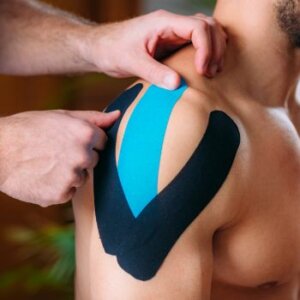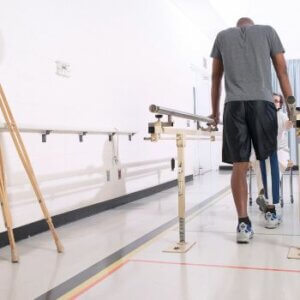Welcome to Park Avenue Physical Therapy, where we prioritize your well-being and are dedicated to restoring your body’s optimal function. Our expert team of compassionate physical therapists in Huntington is committed to providing personalized and compassionate care to help you overcome pain, regain mobility, and enhance your overall quality of life. Whether recovering from an injury, managing a chronic condition, or seeking preventive care, our state-of-the-art facility and evidence-based treatment approaches ensure that you receive the highest standard of physical therapy. At Park Avenue Physical Therapy, we believe in empowering you on your journey to wellness, guiding you toward a healthier, more active lifestyle. Discover the transformative possibilities of rehabilitation with our trusted and experienced professionals, who are here to support you every step of the way.
Physical Therapists In Huntington

3 Indicators That You Need to See Physical Therapists In Huntington
Each of your sciatic nerves runs from either side of your lower back down to each of your legs. That’s why a classic sign of sciatica is having a shooting pain on one side only. While compression of one of your sciatic nerves can literally be a “pain in the butt,” it doesn’t always require medical attention. Yet sometimes physical therapy is your best bet to banish sciatica symptoms. So how can you tell when to go it alone, and when to call Park Avenue Physical Therapy ?
 1. If Home Treatments Aren’t Working
1. If Home Treatments Aren’t Working
There are plenty of things you can do at home to ease a mild sciatica flare-up. Alternating with cold and heat is a classic treatment for sciatica symptoms. Use an ice pack, followed by a heating pad, for about 15 minutes per application. Sleeping with a pillow between your knees can also help. If you can’t get comfortable during the day or at night, try a reclining chair to redirect the pressure from your lower back. Going for walks often helps ease sciatica pain, because “babying” your condition can actually make it worse.
Yet while these methods may help with mild sciatica, there are times when a physical therapy session is a far better strategy. One sign that you should consult a physical therapist is if your home treatments are having little or no effect in reducing the pain and restricted motion. Another is if the symptoms persist for at least a week. Of course, the worsening of pain is the most important sign that physical therapy is needed.
2. When Sciatica Symptoms Become Severe
If your sciatic nerve becomes seriously compressed, the resulting symptoms can go from uncomfortable to quite painful – and even embarrassing. You may become weak and numb on one side. Sometimes, even getting your leg or foot to move becomes impossible. If the pain hits you suddenly, and with great intensity, it’s probably time to visit physical therapists in Huntington to begin easing the pain.
Another telltale sign? The sciatic nerve can become compressed in the area that controls bladder and/or bowel function. If you lose control of either or both of these functions, you’ll obviously want to get professional help. Visit a doctor to rule out other problems. They will likely run tests, as well as refer you to a physical therapist.
3. If the Pain Follows an Injury
Mild sciatica can build up over time, and it may even go away on its own. But when you have an onset of classic sciatica symptoms following a car accident, serious fall or sports injury, contact a doctor and a physical therapist. The symptoms are more likely to be severe because of the greater impact on the area surrounding the sciatic nerve. It’s important to determine the severity of nerve damage. Your medical team needs to evaluate the need for surgery, steroid injections or prescription drugs.
Of course, even if your injury requires more aggressive treatment, physical therapy is often recommended as part of the recovery plan. Your physical therapist can help you with surgery rehab. He or She can also focus on extending the benefits of your injections and sciatica medication.
For many people with persistent or severe sciatica, physical therapy can be a lifeline. You’ll be taught targeted moves that strengthen your lower back. Strong muscles support the area around your sciatic nerve and can prevent future injuries. You’ll also work on improving your posture to keep sciatica symptoms at bay. Increasing range of motion is also part of physical therapy for sciatica.
Contact Park Ave Physical Therapy today to speak with experienced physical therapists in Huntington about how to manage – and even banish – painful sciatica flare-ups.
What Is The McConnell Technique?
The McConnell taping technique is used to realign the patella (kneecap) with medical tape to support and decrease pain from injuries. It was initially developed in 1984 by Jenny McConnell, a physical therapist in Australia. The technique is simple and effective and can be used on our patients to engage in physical therapy without pain. At Park Ave PT, our specialists use techniques, like the McConnell taping technique, to provide relief to our patients.
 McConnell Taping Technique Application
McConnell Taping Technique Application
One 1/2-inch wide medical tape, 2-inch wide adhesive gauze, and scissors are needed for the McConnell taping technique. On clean skin, the following steps will be administered during physical therapy by our physical therapists in Huntington:
- Cut two strips of the gauze and one strip of the medical tape. The strips should be about 3 to 5 inches long.
- While seated, extend the knee and relax the leg. Place both strips of the gauze over the kneecap.
- Place one side of the medical tape strip on the outer edge of the kneecap. Pull the other side of the strip toward the inner knee. At the same time, push the soft tissue on the inner knee toward the kneecap.
- Finally, adhere the end of the tape to the inner edge of the kneecap.
Advantages Of The McConnell Taping Technique
Studies have shown that the McConnell taping technique effectively provides relief to kneecap injuries and improves motions. Some specific advantages of the method include the following:
- This technique reduces pain from knee osteoarthritis, patellofemoral pain syndrome, and chronic knee pain.
- It improves the disability of the knee in patients with knee osteoarthritis.
- Increases quadricep functions, allowing the patellofemoral joint to take on more weight.
- Increases knee flexion, resulting in faster walking in patients with Patellofemoral pain syndrome.
- It helps realign the patella.
Contact Park Ave Physical Therapy
If you are interested in learning more about the McConnell taping technique or would like to apply the method to your knee during physical therapy, contact Park Ave PT. Our physical therapists in Huntington are trained to administer the technique and want to alleviate your pain. Schedule an appointment with our facility today to see how we can help!
The Importance Of Prehabilitation: Preparing For Surgery With Physical Therapy
In the realm of medical advancements, prehabilitation has emerged as a crucial component in optimizing surgical outcomes. At Park Avenue Physical Therapy, we firmly believe in the transformative power of prehabilitation, mainly when facilitated through structured physical therapy programs. As pioneers in the field, our physical therapists in Huntington recognize the profound impact that proactive preparation can have on the overall success of surgical interventions.
 What is Prehabilitation?
What is Prehabilitation?
Prehabilitation, often referred to as prehab, is a proactive approach to healthcare that involves preparing individuals for upcoming medical procedures. Unlike traditional rehabilitation, which occurs post-surgery, prehabilitation focuses on optimizing physical and mental health before the surgical event.
The Role of Physical Therapy
Physical therapy is central to the prehabilitation process, a specialized form of rehabilitative care that targets specific areas of the body to enhance strength, flexibility, and overall functionality. Through a tailored regimen of exercises and interventions, physical therapy aims to fortify the body, enabling it to withstand the rigors of surgery more effectively.
Advantages of Prehabilitation Over Conventional Approaches
- Reducing Complications – One of the primary benefits of prehabilitation is its proven ability to minimize the risk of post-surgical complications. By engaging in targeted exercises, patients can improve cardiovascular health, respiratory function, and muscular strength, all of which contribute to a smoother recovery process.
- Accelerating Recovery – Prehabilitation sets the stage for a swifter recovery post-surgery. Strengthened muscles and enhanced flexibility facilitate a quicker return to normal activities and contribute to a more comfortable rehabilitation phase.
- Enhancing Mental Resilience – Surgery can be mentally taxing, and prehabilitation extends its benefits beyond the physical realm. Engaging in preoperative physical therapy has been linked to reduced anxiety levels and improved mental resilience, ensuring patients approach surgery with a positive mindset.
Tailoring Prehabilitation to Individual Needs
At Park Avenue Physical Therapy, we recognize that every patient is unique, requiring a tailored approach to prehabilitation. Our team of experienced physical therapists in Huntington collaborates with patients to design personalized exercise regimens that address specific needs and concerns.
Nutritional Guidance
In addition to physical exercises, prehabilitation encompasses comprehensive nutritional guidance. A well-balanced diet is pivotal in fortifying the body, promoting optimal healing, and supporting the energy demands associated with surgery.
Our Commitment to Excellence
We stand as a beacon of excellence in prehabilitation at Park Avenue Physical Therapy. Our commitment to enhancing surgical outcomes through innovative physical therapy approaches sets us apart as leaders in the field.
Contact Us
Embark on your prehabilitation journey with Park Avenue Physical Therapy. Our dedicated professionals are ready to guide you through a personalized program that ensures you are primed and prepared for your upcoming surgery. Contact our physical therapists in Huntington today to learn more!
Overcome Knee and Hip Pain
Hip pain and knee pain are a part of life for many people. Cartilage in the knees, hip or lower back can wear down due to overuse and lead to discomfort or arthritis. Sometimes just a straight-up injury can cause pain. While some cases are so severe that they could require surgery to repair an injury, there are many situations in which working with a physical therapist can help overcome these pains. Our physical therapists in Huntington have helped many patients overcome knee or hip pain, and Park Avenue Physical Therapy is happy to work with you to help you achieve pain relief and get back to a normal routine.
 Analyzing Knee and Hip Pain
Analyzing Knee and Hip Pain
The first thing your physical therapist will do is an evaluation to figure out where you’re experiencing pain and the type of pain. Hip pain, for example, can be located in the groin, the front of the hip, the side, the lower back or the buttocks. Knee pain can be on the front or back of the knee joint; it could also be due to a medial injury on the inside of the knee, or iliotibial band stress, which leads to pain on the outside of the knee.
Hip pain tends to feel like a constant dull ache. Knee pain, however, is often assessed as one of several different types of pain:
- Acute: This is the most intense type of knee pain, and it usually occurs in the first week after an injury. If you’re experiencing acute pain, your doctor or therapist will simply recommend rest and isolation of the knee for at least a week to let it heal.
- Subacute: Two to six weeks after an injury, the pain will still be intense, but far less than the acute pain of the first week. During this time, your physical therapy can include gentle motions around the knee to try to increase range of motion and facilitate healing.
- Chronic: This is pain that lasts for longer than two or three months. If you’ve been living with serious knee pain for that long, it’s a good idea to see a specialist for a full exam and X-rays.
Getting Started With Physical Therapy
After your initial conversation with a physical therapist, it will be time for some further testing of your knee or hip pain. The process for both types of injury will be similar to this:
- Gait Analysis: Your physical therapist will assess how you walk to determine if anything is out of the ordinary with your gait.
- Palpation: Some gentle palpation of the knee or hip with the therapist’s hands will help to check the knee structure or hip to find where the pain is originating.
- Check Range of Motion: Your physical therapist will measure to see how far your knee or hip can bend. This will help determine the course of therapy, because it will give your specialist an idea of the types and intensity of exercises you should begin working on.
- Strength Checks: Testing the strength of your knee and hip structures will give the physical therapist an idea of whether your pain is due to an injury or imbalance of some type.
Your physical therapist will also check your balance and measure any swelling that is detected around the impacted joint. Then, you’ll likely go through a series of special physical therapy tests; this is the final step in analyzing your knee pain and will allow your physical therapist to prescribe a course of exercises.
Most of your physical therapy exercises will be “prescribed,” meaning you’ll be able to do them on your own at home. These exercises will help strengthen the muscle structures around the knee or hip (or both). Your physical therapist will likely also run you through the exercises during regular checkups to monitor your progress and to make sure you’re on the best course of treatment.
If you’re ready to kick knee and hip pain to the curb, contact Park Ave Physical Therapy Huntington, NY today to schedule an appointment with one of our physical therapists in Huntington.


